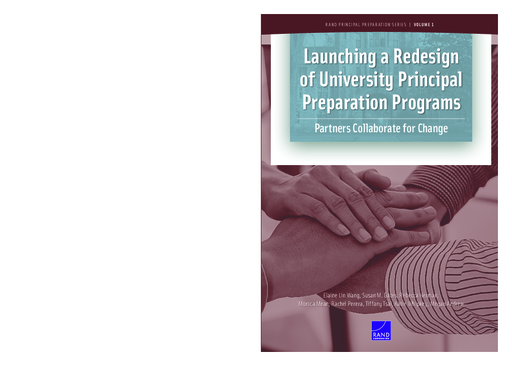- Author(s)
- Elaine Lin Wang, Susan M. Gates, Rebecca Herman, Monica Mean, Rachel Perera, Tiffany Tsai, Katie Whipkey, and Megan Andrew
- Publisher(s)
- RAND Corporation
- DOI Link
- https://doi.org/10.7249/RR2612
Research Approach
This study examines the goals and outcomes of the first year of the University Principal Preparation Initiative. Researchers analyzed data collected through site visits, interviews, and focus groups. They sought to answer the following research questions:
- Program Changes: To what extent and in what ways have university programs modified their principal preparation programs?
- Management of the Redesign Process: How did the university-based leads of the effort manage the redesign process?
- Partner Engagement: To what and how extent did partners (districts, state accrediting agency, mentor programs) support the program change?
- Challenges and Strategies: What challenges were encountered in the program redesign process, and how were they addressed?
- Changes in Candidates’ Experiences: What changes in candidates’ experiences can be observed and measured within the five-year study time frame?
The focus of this report is on the first four research questions. However, researchers did not answer these questions as if they were in silos. Management and partner engagement, for example, are closely intertwined, and challenges and solutions arise in relation to program change, management, and engagement. The report thus reflects a more holistic picture of initial implementation.
A central goal of this study is to generate lessons that other university principal preparation programs and their partners within the selected state and across the country can adopt or adapt as they undertake their own principal preparation system improvement efforts. In line with this, the initial implementation study seeks to identify themes that cut across sites. Even in doing so, researchers attempted to recognize and attend to the unique context of each university program and its specific approach to UPPI.
For example, while they focus on cross-site themes throughout this report, they present selected examples that are grounded in specific programs for illustrative purposes. They gathered data for this report throughout 2017. Two-person teams conducted site visits in spring 2017 to the seven universities and returned for a second site visit in fall 2017. Each site visit consisted of interviews with the UL heading the redesign and persons leading the effort from the program, districts, state agency, and mentor program. In the spring, researchers also interviewed university administrators and conducted focus groups with principal candidates, program faculty, and district mentors. Topics tracked efforts to answer the first four research questions. When they visited the sites in fall 2017, researchers observed a scheduled UPPI leadership team meeting, during which the core team discussed issues, worked on a redesign task, or otherwise conducted business as usual. They also collected documents, such as program handbooks and syllabi, that characterized the university program and relevant district and state policies prior to UPPI. Finally, on a regular (e.g., monthly) basis after the initial site visit, they conducted brief phone or online check-ins with the UL and the lead of each partner district.
All interview and focus group data were transcribed, coded, and analyzed in Dedoose (SocioCultural Research Consultants, 2016), a cross-platform Internet application that assists with qualitative data. Data analysis was guided by analytical questions keyed to the first four primary research questions. More information about data collection and analysis is available in Appendix C of the report.






